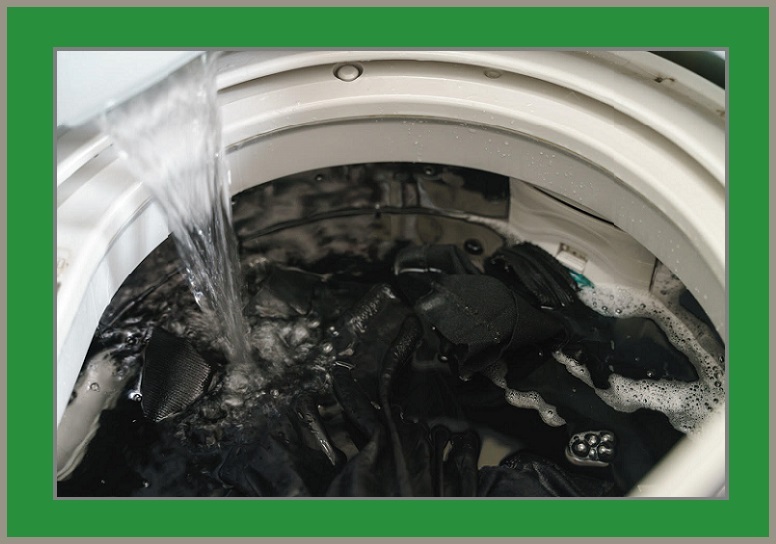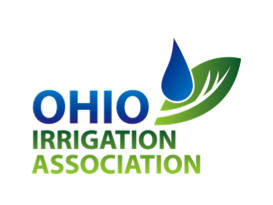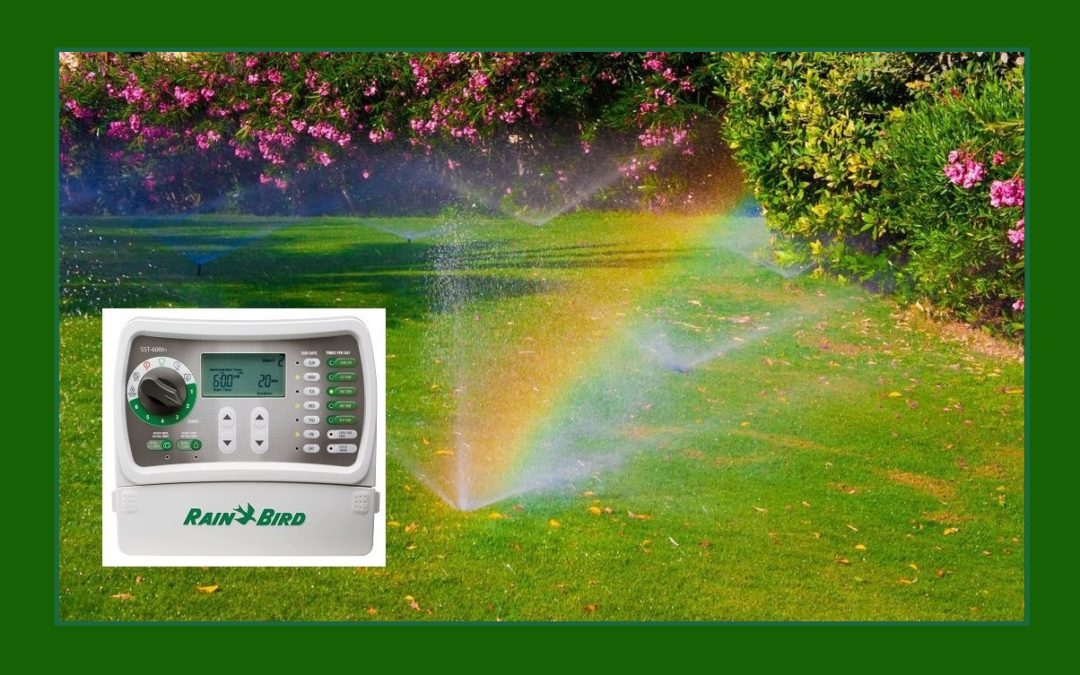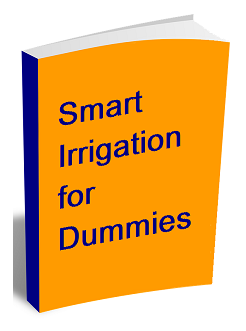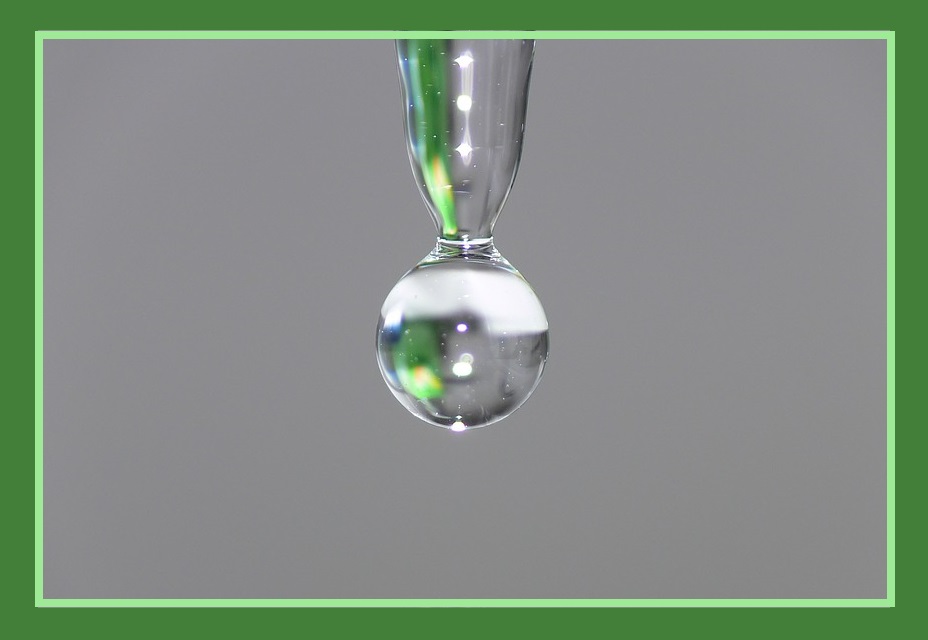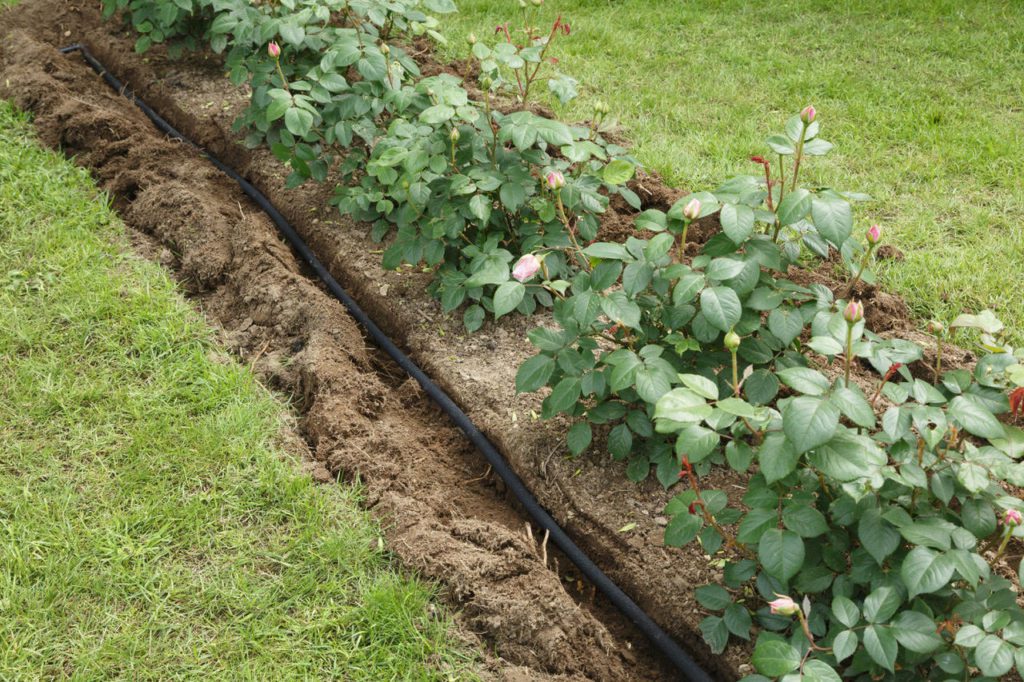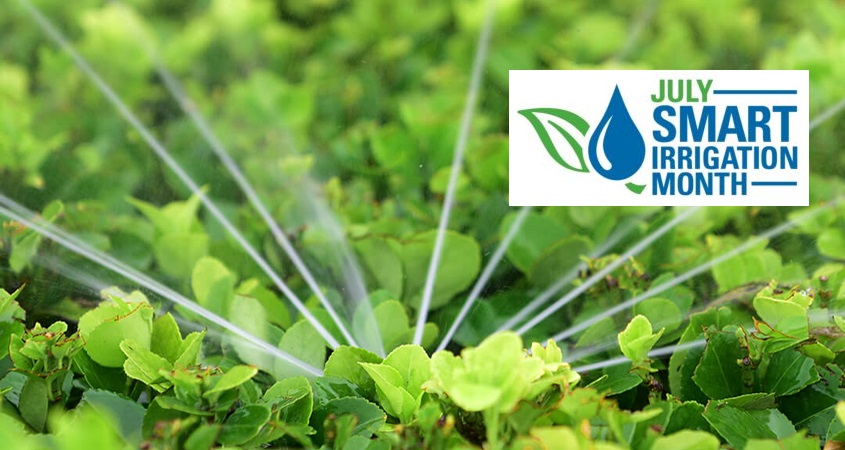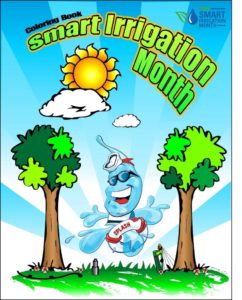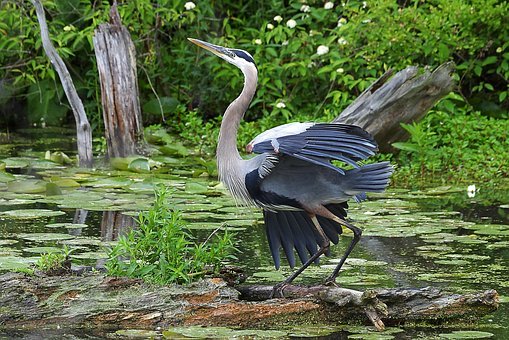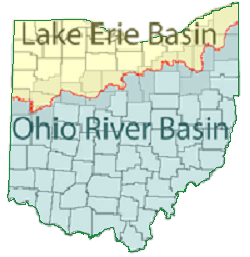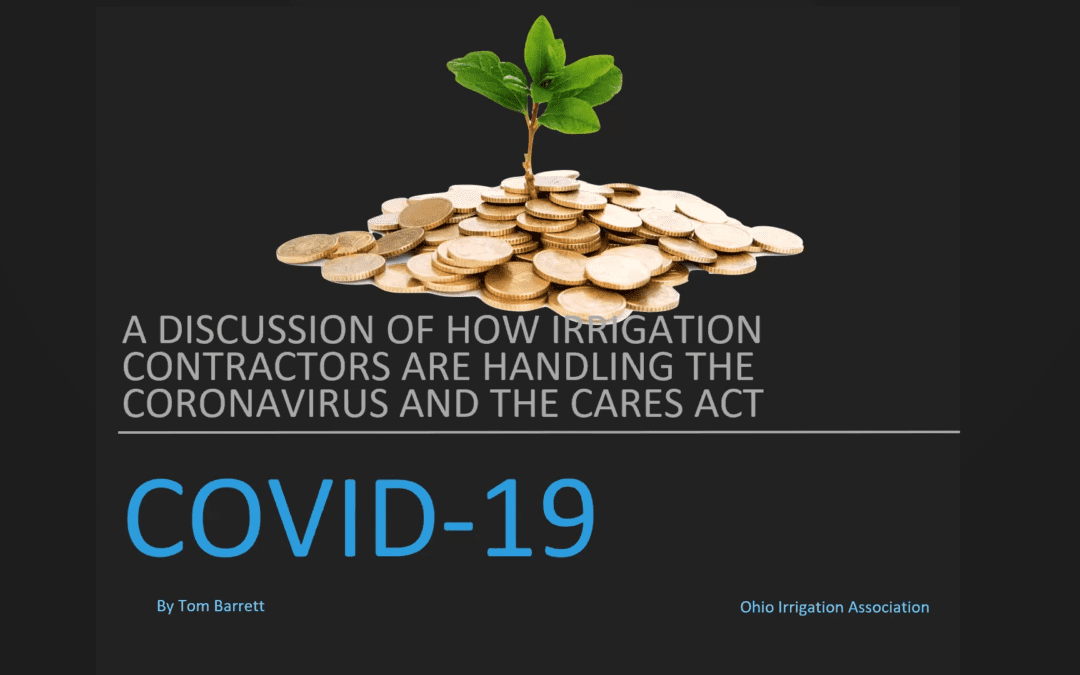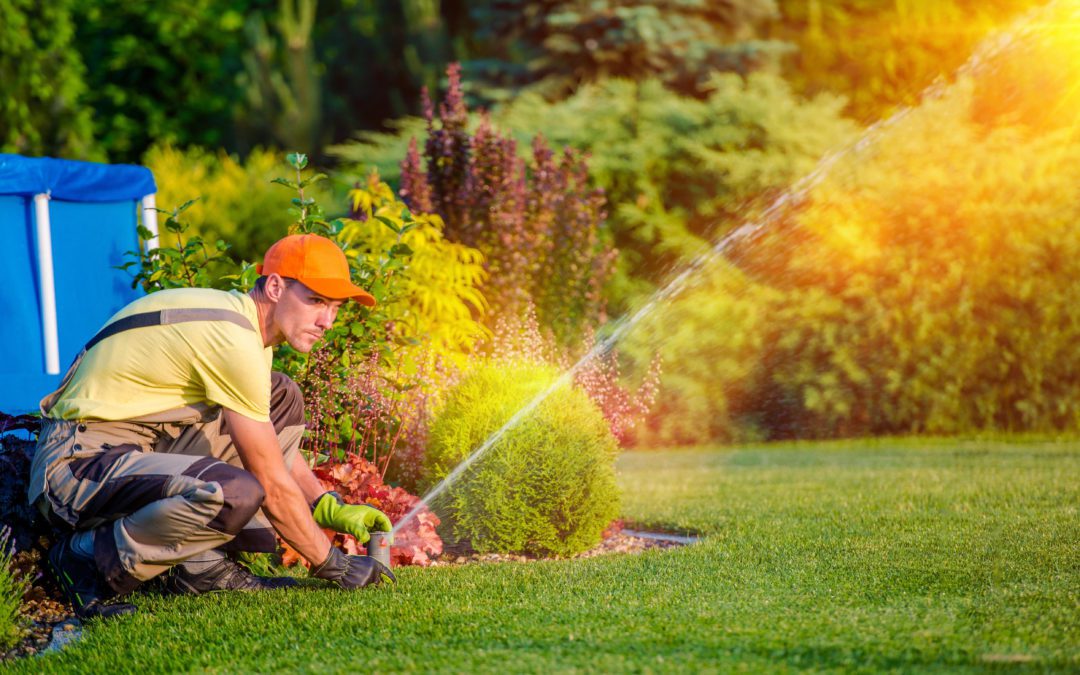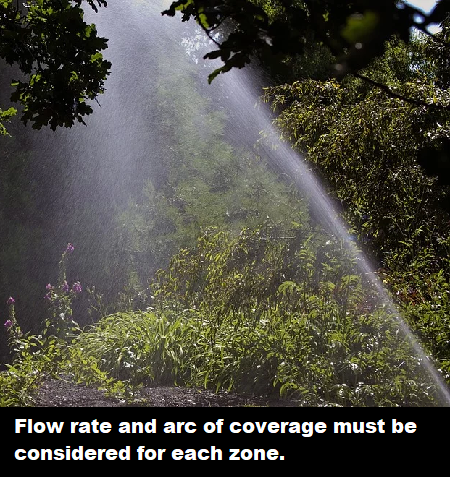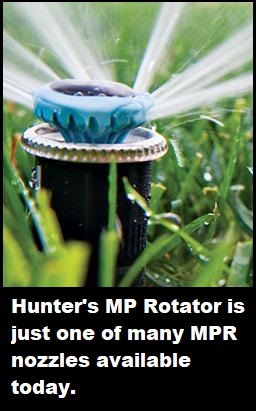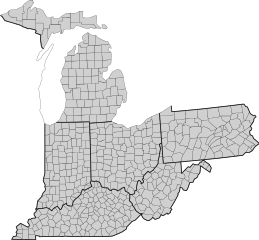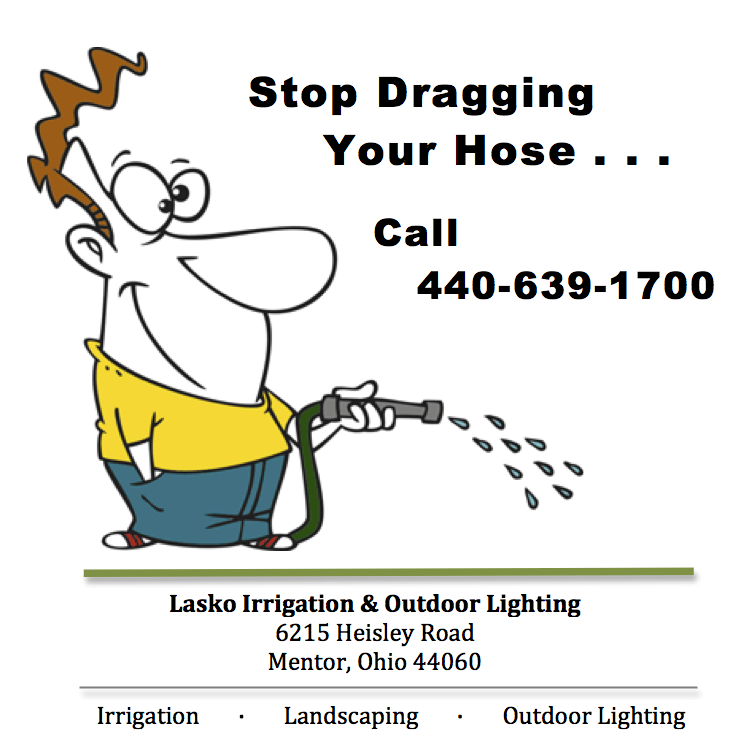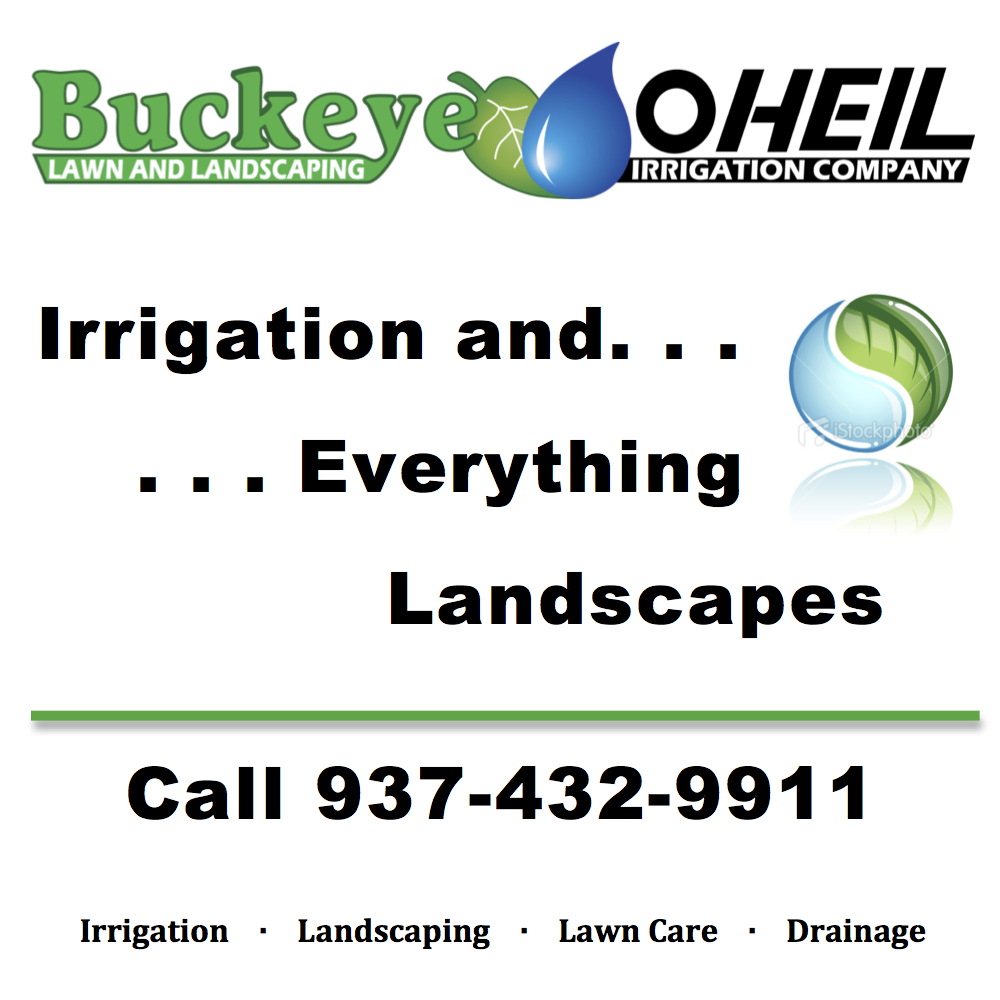
by Tom Barrett | Sep 9, 2020
Predicted Water Shortages Driving Demand for Greywater Irrigation
Water scarcity is an issue we normally associate with the western United States. But a recent U.S. Forest Service study predicts that Ohio and the rest of the Midwest also will be threatened by significant water shortages in the next few decades.
And the U.S. Government Accountability Office (GAO) expects that all but 10 states will experience shortages as early as 2024.
In such an environment, greywater irrigation systems will become increasingly popular, and perhaps even mandatory for commercial properties.
What Exactly Is Greywater?
Greywater (also spelled “gray water” or “graywater”) is gently used water from washing machines, bathroom sinks, tubs and showers.
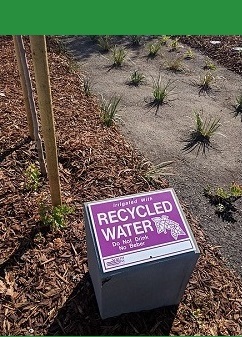
The city of San Antonio, Texas, has the nation’s largest direct recycled water system, with a capacity to deliver about 29 million gallons per day of treated recycled water, using more than 130 miles of pipeline.
Source: San Antonio Water System
The name comes from its rather murky appearance, caused by traces of dirt, hair, grease, food and some household cleaning products.
Unlike “blackwater,” greywater has had no contact with any human waste from the toilet, sewer system, or from washing diapers. So while it may look dirty, greywater is a safe – and even beneficial – irrigation source. The same greywater that currently pollutes our lakes and rivers with its trace biomaterials becomes valuable fertilizer to plants.
(Greywater is not potable, however, and should never be consumed by humans or animals.)
Greywater vs. Recycled Water
Greywater is often confused with reclaimed (or recycled) water. And the terms are often used interchangeably. But they are not the same.
Recycled water is sewer water that has been cleaned with chemicals at a sewage treatment plant. It is then delivered to an entire community via purple-colored pipes, and is used primarily to irrigate parks, golf courses and other public areas.
Components of a Greywater System
Greywater irrigation is comprised of three primary stages: collection, storage and use. This can be as simple as a single diverting valve on a home’s washing machine, or a complex system of pumps, filters, storage tanks and pipes. The result is filtered greywater delivered directly to lawns, gardens and other landscaped areas via the property’s irrigation system.
–Article Continues Below–

The most basic greywater system uses a three-way valve to connect a clothes washer with a home’s irrigation system. Another excellent source of greywater is condensate from an air conditioning system, which can produce as much as 20 gallons of water per day. Integrating with a smart irrigation controller ensures water efficiency.
The water may be delivered via driplines or spray heads, but all pipes and fixtures must be purple and designated as greywater conveyors of non-potable water. The water may be used to irrigate ornamental plants, fruit trees and vegetable plants other than root vegetables, but it must not touch any edible portion of the plant.
Benefits of a Greywater System

Greywater
in Ohio
Greywater can be reused and recycled in Ohio with a permit from the local health department (Ohio Code 3701-29-17).
All pipes and fixtures conveying greywater must be purple or marked with a purple stripe and be labeled “Non-potable water, do not drink.”
There are four types of greywater systems permitted in Ohio:
TYPE 1 recycles less than 60 gallons per day. Used for subsurface irrigation of gardens, lawns and landscape plants during the growing season.
TYPE 2 recycles more than 60 gallons per day but less than 1,000 gallons per day. Also used for subsurface irrigation of gardens, lawns and landscape plants during the growing season
TYPE 3 recycles hand-carried gray water that is poured through a screen into a disposal sump tank before discharging into leach field trenches. Commonly used in campgrounds, Amish homes and remote vacation homes.
TYPE 4 recycles treated greywater to be reused year-round outside or inside buildings. Water is stored for no longer than 24 hours before reuse. Outdoors, used for green roofs, living walls, surface and subsurface irrigation of lawns, gardens, and landscape plants. Indoors, used to irrigate houseplants or living walls.
Source: Ohio State University
- Greywater systems save water and money. Manufacturers of greywater systems state that greywater irrigation can save as homeowners much as 40,000 gallons of water per year. The result is a dramatic decrease in water bills, especially during the summer months. According to Saniflo spokesman Chris Peterson, “Homeowners who begin recycling greywater now could be well ahead of the curve if and when their states begin requiring water conservation measures.”
- Greywater systems prolong the lives of septic tanks because the amount of water being deposited into the system is greatly reduced.
- Most ornamental plants find greywater to be more beneficial than tap water. Greywater contains residues, such as nitrogen, which many plants can use for food. Roses, bougainvilleas and honeysuckle particularly benefit from greywater irrigation. In addition, slightly soapy water will percolate more deeply into the soil, preventing runoff.
What It Means for Irrigation Contractors
The experts at Rain Bird believe that many (if not most) of new commercial building projects will soon require greywater or some other water-harvesting system be integrated into their landscape irrigation designs. (Hunter Industries currently uses greywater irrigation at all of its operational sites.)
In other words, irrigation professionals who haven’t yet designed and installed these systems will do so in the near future.
Want to Learn More?
Rain Bird’s Design Guide for Non-Potable Water Irrigation Systems can get you started on ways to incorporate greywater irrigation in your menu of services.
Sources:
Featured Image: Adobe, License Granted
Science Alert
WateReuse
Medium
Rain Bird

by Tom Barrett | Aug 5, 2020
Are Your Customers Still Using Standard Irrigation Timers?
Smart technology may be everywhere, but irrigation contractors know that standard, old-school irrigation timers are still very much out there.
These basic clock timers are still being manufactured, installed and maintained—so they’re not going anywhere soon. According to Rick Arena, a training manager at SiteOne in North Carolina, “Probably 75% or more of all controllers sold right now are still the old style.”
And while they’re not capable of making any complicated decisions, for certain applications, these “old timers” are actually better suited.

How to Get Smarter
Just about every “dumb” irrigation controller made in the last decade or two includes sensor terminals for connecting to a rain or soil-moisture sensor.
Numerous add-on devices are available, such as:
Hunter’s Rain-Clik, Mini-Clik, Freeze-Clik, Soil-Clik and Mini-Weather Station devices, which will work with virtually any controller.
Rain Bird offers a LNK Wi-Fi module for weather-based water management, which can be plugged into any of their ESP-TM2 and ESP-Me Series controllers that were manufactured after Nov. 2, 2016. For Rain Bird controllers made before that date, a Wi-Fi-compatible replacement panel can be installed.
ETwater from Jain offers a retrofit smart controller which can be attached in less than 10 minutes and is compatible with all irrigation controller brands.
Keep It Coming
A perfect example is a new lawn, whether sod or seed. With standard irrigation timers, the water is applied at regular intervals with no exceptions. Which is what you want with new turf: frequent, short bursts of water for at least 30 days, until the grass takes root.
In fact, standard timers are often installed (at least temporarily) to maintain curb appeal for newly built homes.
Paradign Shift
Another reason standard timers are still in demand is their simplicity. As it turns out, not every homeowner wants an irrigation controller that uses ET data, local weather forecasts or various sensors for its watering schedule.
Rain Bird product manager James Harris explains it this way: “New technology like smart controllers always has an adoption curve, and not everyone is ready to adopt it at the same time.”
Particularly for some older homeowners, a smart controller may as well be speaking a foreign language. They can be baffled by all the settings. And they’re not interested in investing their time learning to set up and use the latest technology. Millennials, on the other hand, naturally gravitate toward and embrace technological advances. As this younger demographic continue to purchase homes, the demand for smart controllers will likely increase.
–Article Continues Below–

This required paradigm shift applies to contractors, as well. Ramzi White is a SiteOne key account manager in Texas. He says the standard Hunter or Rain Bird clock timers are still his best sellers. In fact, many contractors in his area don’t really even know what a smart controller is.
Know Your Customer
As an irrigation contractor, the decision to offer smart technology to your clientele often comes down to knowing the customer. A 70-year-old who’s just learning how to email and text is probably not a good prospect for a smart controller. Some younger people may also prefer to have fewer bells and whistles.
But generally speaking, homeowners in their mid-40s or younger, who’ve essentially grown up with technology, enjoy integrating new gadgets into their homes. For them, smart controllers can be a very easy sell.
Sources:
Featured Image: Adobe, License Granted
Irrigation & Green Industry
Jain USA
Rain Bird

by Tom Barrett | Jul 8, 2020
Making Every Drip Count with
Drip Irrigation
Since July is Smart Irrigation Month, let’s explore one of the most effective means of conserving water in a landscape: drip irrigation.
A drip system may not be the first thing most people envision when they think of landscape irrigation. But these highly efficient systems not only conserve water, they also can irrigate slopes and oddly shaped areas with precision.
Drip Irrigation Basics
Drought in Ohio
Since 2000, the longest duration of drought in Ohio lasted 44 weeks beginning on July 23, 2002, and ending on May 20, 2003. Drought conditions ranged from “moderate” to “exceptional” during this period.
On the other hand, the most intense period of drought occurred during the week of September 4, 2007, when “extreme” drought affected more than 11 percent of the state’s land.
Source: National Integrated Drought Information System
Drip irrigation slowly and steadily delivers gallons of water per hour, as opposed to gallons of water per minute like sprinkler systems. And because the water is directed to the plants’ roots, runoff and evaporation are minimized. So less water is required.
A drip irrigation system consists of the following basic components:
- Water valve
- Backflow preventer
- Pressure regulator
- Filter
- Tubing adapter
- Dripline (PVC or polyethylene tubing)
- Emitters
- Electronic controller
Once the basic system is installed, any number of lateral lines can then be attached through various headers. Each line is fitted with water-dispersing emitters, and then can either be buried or covered with mulch.

Adobe Image, License Granted
When it comes to the dripline, contractors have two options: Insert the emitters anywhere you wish along the line, or purchase lines with pre-inserted emitters at regular intervals.
However, choosing the correct emitter is important. Output rates for emitters vary from a half gallon to two gallons per hour. Emitters with different output rates may be installed on a single dripline. This comes in handy if you need to irrigate plants with distinct watering needs that are located close together.
Adjustable emitters are also available. These allow you to regulate the water flow rate, from a steady drip to a slow stream.
Drip System Applications
Drip systems are primarily used to water flower beds, gardens and particularly small or unique landscape areas. They’re perfect for xeriscape-type gardening which requires limited irrigation.

Adobe Image, License Granted
But they can also be used to provide supplemental irrigation. For instance, drip irrigation can be added to bedding areas that are already incorporated into sprinkler zones.
In addition, drip systems can be used to irrigate larger areas, such as both new and already-established lawns. For a new lawn, simply install the dripline before sodding or planting grass seed. With an established lawn, the drip line is trenched into the turf.
Maintenance
Typically, drip systems are easier to maintain than sprinkler systems, because the emitters and dripline aren’t deeply buried. The trick is in determining when a repair is needed. Whereas a broken sprinkler head is easily identified, with a drip system, you must look for browning or wilting vegetation.
Which is why you’ll want to incorporate a flow meter in the system. This sensor will notify the controller of any flow irregularities. An alert is then sent to the home owner’s smartphone. Wireless flow meters are both affordable and easy to install.
Selling Points
Drip irrigation systems offer numerous benefits your customers should know about:
- Better plant health. Water penetrates slowly and deeply into the soil, placing moisture exactly where it’s needed – at the roots. Plants grow quickly when they are watered uniformly without stress created by lack of water.
- Less waste. A good drip irrigation directs 90 percent of the water into the soil, with very little lost to evaporation.
- Environmental benefits. Because drip irrigations are so effective, there is less chance of erosion, with very little runoff ending up in area streams and rivers.
- Reduced risk of disease. Drip irrigation keeps the foliage dry, thus reducing the incidence of powdery mildew and other diseases that occur in damp conditions.
- Weed control. Drip irrigation systems place water directly around the plant. As a result, weed seeds are water starved and germination is limited.
Like sprinkler systems, drip irrigation requires winterization. Be careful, however, that you don’t use too much air pressure when blowing out the lines. (You don’t want the emitters to pop off.) It’s also a good idea to store the backflow preventer and irrigation controller indoors for the winter.
For spring start-ups, be sure to inspect all components for cracks and splits that can occur in very cold weather.
Expanding Market
If climate experts are correct, drier days are ahead for most of the country. Which is one reason drip irrigation has become increasingly popular over the last decade.
At times of severe water restrictions, homeowners with drip systems are often allowed to irrigate several more days per week because of the greater efficiency of these systems. (In fact, these customers may be exempt from watering restrictions altogether.)
And although properly installed drip systems are typically more expensive that sprinkler systems, that initial expense is offset by the cost of water savings over time.
Drip irrigation may not represent a total change of direction for landscape irrigation contractors. But it does nevertheless represent an expanding market and is well worth adding to your menu of services.
Sources:
Featured Image: Pixabay
Irrigation & Green Industry
Wolf Creek Company

by Tom Barrett | Jun 3, 2020
Market Your Business as a Leader During Smart Irrigation Month
July is Smart Irrigation Month. Are you geared up to market your company as a leader in water-saving practices?
It was 16 years ago that the national Irrigation Association (IA) first utilized the month of July to promote the social, economic and environmental benefits of efficient landscape irrigation. And every year, Smart Irrigation Month has gotten bigger and better.
New Tools
Again this year, the IA has added some new tools to help irrigation contractors market smart irrigation throughout the month of July. Such as:
–Article Continues Below–

Get Everyone on Board!
But that’s not all. As in previous years, there are a myriad of other ways that you can demonstrate smart leadership:
- Add the Smart Irrigation Month logo to your website, email signature, ads, customer presentations, field signs, invoices and more.
- Submit a press release or letter to the editor of your local newspaper.
- Partner with your local water provider.

- Ask your local radio station to play a public service announcement.
- Encourage sales and marketing staff to participate in dealer and distributor Smart Irrigation Month activities.
- Host a live demonstration of water-saving irrigation technologies in the field or at your location.
- Feature water-efficient products and services in displays, ads, promotions and product demos with the Smart Irrigation Month logo.
- Make smart irrigation the theme of sales calls.
- Distribute awards to customers and/or business partners who promote water-efficient practices.
2019 Video Contest Winner
Also included in IA’s July promotion is the smart irrigation video contest. Last year’s contest winner was Florida-based NatureScape Irrigation Service. Take a look:
Source:
Irrigation Association

by Tom Barrett | May 6, 2020
Ohio Watersheds Are Crucial to
Its Sustainability
We all live in a watershed.
Residential areas, farms, forests, small towns, big cities …They’re all part of a massive watershed network. Watersheds cross municipal, county, state and even international borders.

Pixabay Image
They come in all shapes and sizes, encompassing millions of square miles or just a few acres. And like creeks that drain into rivers, small watersheds are almost always part of a larger watershed.
For instance, Ohio’s 23 major watersheds consist of 254 principal streams and rivers. But they all drain into either Lake Erie or the Ohio River. (See “Ohio’s Two Primary Watersheds,” below.)
Our landscape and all its activities interconnect with streams, lakes and rivers through their watersheds. Naturally varying lake levels, water movement to and from groundwater, and amount of stream flow influences them as well. The health of our waterways is largely determined by these dynamics between the land and the water.

Ohio’s Two Primary Watersheds
In Ohio, rivers north of the Continental Divide flow to Lake Erie and the St. Lawrence Seaway. Rivers south of the Divide flow to the Ohio River and, eventually, the Gulf of Mexico.
Learn more about the Lake Erie watershed:
Learn more about the Ohio River Watershed:
Becoming Watershed Wise
Watersheds must be protected if they are to sustain life. When human activities alter the natural function of the watershed, residents can be adversely affected by frequent flooding and routine periods of drought.
The three leading causes of polluted waterways are:
- Sediments
- Bacteria (such as E. coli), and
- Excess nutrients (such as nitrogen- and phosphate-based fertilizers).
Watershed-wise practices help create a balance and allow nature to work in our favor. When properly employed, residential landscapes can function as healthy mini-watersheds. The Green Gardens Group (G3) provides training and certification for its Watershed Approach to landscaping. This approach includes four key elements:
- Build Healthy Soil
- Capture Rainwater
- Select Native, Climate-Appropriate Plants
- Use Highly Efficient Irrigation
Smart irrigation technology (smart controllers, rain and soil-moisture sensors, and pressure regulators) is a key component of this approach and ensures optimal irrigation system performance.
Best Practices
As an irrigation and landscape professional, are you practicing watershed-wise principles, or are you contributing to the problem? Here are a few tips:
- Promote smart irrigation controllers and other technology with your customers, to ensure that runoff is reduced or even eliminated.

- Utilize matched precipitation rate (MPR) nozzles.
- Suggest that your customers create hydrozones (groups of plants with similar water needs) to conserve water.
- Offer your customers natural alternatives to nitrogen- or phosphate-based fertilizers? And suggest integrated pest management instead of pesticides.
- Make sure that roof runoff is directed onto a grassy area, not a sanitary or storm sewer system.
- Suggest porous surfaces for landscaping (such as flagstone, gravel or interlocking pavers), rather than impervious surfaces like concrete.
- Consider installing irrigation systems that draw from rainwater or gray water, whenever possible.
- Remind your customers that irrigation system management is critical! Systems must be actively and constantly managed in order to be watershed wise.

Take a Virtual Tour of
Ohio Watersheds
The Ohio Watershed Network offers a virtual tour of Ohio’s watersheds, beginning with the smallest streams in the watershed, the Headwaters.
From there, they move through the wider, slower-moving creeks and floodplains of the Middle Reaches. Then to the lakes, ponds and reservoirs, where sediments and many contaminants can collect.
The next stop is the precious Wetlands, with its large variety of plant and animal life. Finally, the last stop on the watershed tour is the Mighty River, where sediments, debris, or contaminants empty into the receiving waters.
We all affect the watershed, one way or another. Whether our individual influence is positive or negative is up to us.
Sources:
Featured Image: Pixabay
The Nature Conservancy
Green Gardens Group
WKYC
Ohio EPA

by Tom Barrett | Apr 13, 2020
A Discussion of How Ohio’s Irrigation Contractors are Responding to the Coronavirus
Jerrad Lee, President of the Ohio Irrigation Association, conducts a round table discussion of landscape irrigation contractors’ response and experience with the coronavirus pandemic. Jerrad reviews the current best practices for shelter-in-place, essential business services, and the CARES Act.
Webinar Transcript
Tom Barrett, Ohio Irrigation Association:
Good afternoon everyone. My name is Tom Barrett and we’re pleased to have you join us in this discussion of how the irrigation contractors are handling the coronavirus and the CARES Act. Presenting for us today is Jerrad Lee, president of the Ohio Irrigation Association. He has 10 years of experience in the landscape industry. Currently, he’s the irrigation services manager for Environmental Management. We anticipate this to be a discussion because we’re all learning here. And so if you have a question, raise your hand and I’ll unmute you or you can type a question in the chat box down at the bottom. So please don’t hold back because, like I said, we’re all learning here. Jerrad.
Jerrad Lee, Ohio Irrigation Association:
Good afternoon, everybody. Can you hear me all right?
Tom Barrett, Ohio Irrigation Association:
You sound great.
Jerrad Lee, Ohio Irrigation Association:
Perfect. My video is not working, but it’s okay. So I wanted to start off by saying thank you to everybody for taking time off on your Friday to join us on this. My goal here, as Tom was saying, is for us to come together as an industry, both distributors and contractors, landscapers, irrigation guys all alike, to come together to figure out exactly the best way to keep our team safe, keep us safe, and keep our businesses rolling as usual. So some of the stuff that I am going to be talking through today, as you can see, is the Covid-19 stuff, obviously. But I really want to go into what you guys are seeing out there, what you’ve experienced, that people weren’t stopping you, that kind of stuff as well as talking about the CARES Act and how it can apply to us.
I’ve got several key points that I want to talk about today, as well as the emergency funds that we can use for our businesses, as well. Kind of the start off, if you’re not confused, you’re not paying attention. So everything that we are going to talk about today, it’s ever changing. It’s changed. About five minutes ago, Tom and I were on a another conference call to learn about some updates to what we’re going to talk about today. And it wouldn’t surprise me if tomorrow it changes again. There you go. Everything’s subject to change. It’s been changing on a daily basis. What I want to talk mostly about is making sure we’re following our shelter in place and we’re keeping ourselves safe, whether that’s with PPE and so on. But here in Ohio, we are not necessarily viewed as “essential.” It’s definitely on a local level as different requirements as to who can and can’t work.
In Pennsylvania , landscapers are not considered essential. So I want to make sure you were aware of that. Ohio, Michigan, Kentucky, West Virginia, we’re allowed to work. But again, it depends on where in the state you are. Some cities won’t let you work and some will. That being said, I’d kind of like to start off with just some input of around the state. So I’m in Columbus. I’d love to get someone from Columbus, someone from Cleveland and someone from Cincinnati to kind of tell us what you guys are seeing out there. Okay? So I’ve heard stories… I believe I was told just today that people in Knox county are getting fines for working. In Columbus, we are working as usual.
Tom Barrett, Ohio Irrigation Association:
Jerrad?
Jerrad Lee, Ohio Irrigation Association:
Yes, sir.
Tom Barrett, Ohio Irrigation Association:
Greg wants to say something. Greg, you’re permitted to talk. I think if you push the space bar, you can talk.
Greg Davis, Environmental Management:
So one thing that we did, we’ve installed a Covid plan pretty early, but we were subject to a a health inspection just last week. There was a random observation of maybe too many folks in a truck. They did stop in and we had our plan together. We showed him everything that we were doing and it was a pretty quick and painless investigation. He liked everything we were doing. But the point is, we had something, we had a plan. We showed them everything we were doing. That causes him to see that we were doing everything we could to stick to the local requirements at that time. Like you were saying, Jerrad, it’s just changing. It seems like hourly. So I mean that’s kind of what we’re doing here. And he reacted to one complaint, so anyone can get a complaint at any time. And he said it was just a random passer-by who just all saw some guys in the truck.
Tom Barrett, Ohio Irrigation Association:
So Greg, did you have something in writing with you?
Greg Davis, Environmental Management:
Oh yeah, he came to our office. And even the week prior, as soon as this started, we had a Covid plan in writing. It’s everything that the employees are supposed to do. It’s a contingency plan for every employee. Like every management play in case they get sick. It runs down who’s going to do what, who’s going to take over and what cross-training they need to get up to speed. We found a camp full of gaps there, especially in like billing and and AR and AP and things like that. But yeah, we had a written plan and we shared it with him. He wasn’t really interested in seeing the actual details. He was more interested in the fact that we had it. You know, when he came in, he was asked the three questions we had to ask every person because we don’t have thermometers yet. And so I think that set him at ease as well.
Nobody from Cleveland is on. This is Scott Knowles. It was in the papers up there, but Impullitti Landscaping had an unannounced stop-by from their local officials. Who I guess said that they were just doing that randomly, seeing who’s open and stopping in to see if they were taking all the precautions for social distancing. In Plenty did. And they had again, like a plan and they had all the stuff in place, you know, the wipes and sprays and people distancing. A couple of the folks, I guess in the office, working from home, and the officials gave them an “all clear,” and congratulated them on doing their job and thanking them for that. So that’s something that you hear more of now, our local officials stopping job sites or offices and questioning. In most cases, just questioning, are they doing what they need to do? So a little feedback there.
Tom Barrett, Ohio Irrigation Association:
Yeah. Thank you. I’ve also heard that in the state of Ohio, the fine could be up to $750 and 90 days in jail. And I’m not sure how true that is, but I have heard that.
Scott Knowles, Wolf Creek Company:
I have not heard the 90 days in jail, but various localities will have fines for second offenses up to, the highest I heard was $1500. And I think that might’ve been Pittsburgh.
Tom Barrett, Ohio Irrigation Association:
Yeah, I think that’s an interesting point. It can vary from locality and county, and it can be more stringent than the state of Ohio. And the state of Ohio appears to have left it a little bit vague, whereas other states have said specifically landscaping is permitted or not permitted. In Ohio it doesn’t specifically point out landscaping.
Joe Twardzik, Wolf Creek Company:
Yeah. Tom. This is Joe Twardzik. Yes. You’re absolutely right. The the local jurisdictions are interpreting as they see fit. The $1500 fine that Scott was referring to, I heard that was actually Montgomery County, which is Dayton. And Scott pointed out about Impullitti, that was actually at their office. So they can walk out and then a previous person talked about getting stopped out and about in the truck. But they can stop in your office, do the same thing. It really is about having a plan in place and actually following the guidelines. So if you do both those things, you’re actually doing, not just writing it down, but walking the walk and talking the talk, that means everything.
Jerrad Lee, Ohio Irrigation Association:
Yeah. And what we did too, to build on what you guys are saying is, we make sure our guys have the key talking points. So my irrigation techs know that they’re protecting a natural resource of water. So that’s along with the landscaping side of things, of keeping a well-maintained landscape. Kind of like the broken glass theory where, if you see one broken window in a house, you’re going to eventually see more. The crime’s gonna start growing. So we’re making sure within this paperwork that they have those key talking points so they know exactly the why’s, they can explain it to themselves. And if you watch John Houston, the lieutenant governor, he will say even that it was all vague, and it’s up to interpretation to the contractor. And the authorities aren’t necessarily going to interpret it. It’s kind of goes back to the way we interpret it, and how we’re doing and how we can advertise what we’re doing and why. So that’s why those key points are essential to have.
Tom Barrett, Ohio Irrigation Association:
We just had several people join us. What we’re talking about here is anybody that’s seen restrictions or anybody that’s been cited with the shelter in place. And in order to participate just press the space bar on your computer and you can talk.
Jerrad Lee, Ohio Irrigation Association:
All right, so kind of moving on. Some of the things that I want to make sure we’re kind of doing. This is some of the best practices that I think we should be following, such as asking for permission. I know when it comes to my tax, we’re not just going to a site even it’s for an outdoor backflow. We want to make sure we’re allowed on that site and what their guidelines are. Maintaining a safe distance. So if we’re going inside of the building, we’re calling ahead. After we get the permission, but we’re still calling ahead, so we can get doors unlocked or a clear path from the outside of the building to where our back floor controller is.
The crew members are using personal vehicles. That’s a great one to keep an eye on. We keep the social distancing. I’m still seeing trucks with five or six guys in them driving down the road. Obviously, some people can’t drive. They may not have a driver’s license or what have you. But doing the best that you can. Kind of going back to what Tom was saying, the local ordinances may be more restrictive, depending on where you are. So even on the national level, out in California, there’s some towns where you can’t be working at all. You get fines, just like Joe and Scott were talking about, in some areas in California you’re fined. And that’s the same thing here. Any more information that you might need? Our website has some guidelines to follow. Feel free to take a look at it. But I know with PPE that I’m seeing guys use, it’s great to see that the people are out there with face mask and gloves and all that stuff.
But what I’m seeing a lot in my experience, watching crews work and different teams work, both within my organization and with another, are people wearing gloves. And that’s great, but they’re cross contaminating everything they touch. So they go out and they may shake someone’s hand or they touch something that could be infected. And then you’re watching them, they’re touching their phone, they’re scratching their face and touching their steering wheel, and then they’re not cleaning the steering wheel off afterwards. So it’s great that they’re having the gloves on, but if that stuff stays on it, then they’re just contaminating everything else as if they weren’t having it. So I’m always making sure my guys have what PP they have and hopefully give them some extra, so they can change their gloves.
Tom Barrett, Ohio Irrigation Association:
And I think it’s important to note this could change tomorrow. In New York, one of my clients is a contractor. On Saturday, a week ago, Cuomo announced that they would restrict all construction except for very essential construction. So the best place for current information is on the website. Anybody hears anything, let us know. We’ll put it up on the website. We want to keep the website as current as possible.
Jerrad Lee, Ohio Irrigation Association:
To kind of go into the CARES Act, is the $8.3 billion Economic Injury Disaster Loan, which we’ll go into in a second. The Paycheck Protection Plan is actually Phase Three. It’s HR bill 748. It’s a $2 trillion stimulus package, which is the biggest package that I think we’ve seen in our lifetimes. So as of a week and a half ago, I was on a conference call and some of the stuff that we learned then has already changed to now. So a week and a half ago, it started off at $349 billion is in this fund. It is now being increased by $250 billion, which makes it $600 billion all in. These funds will be disbursed basically over an eight-week period. So this is built on a 78 program through your SBA. So Tom, if I misspeak on anything, please don’t hesitate to interject.
Tom Barrett, Ohio Irrigation Association:
Yes. So what I’m hearing, there’s about 15 companies that I’ve worked with that have applied for this. The Paycheck Protection Program is designed to maintain your employees so that, when work becomes more normal, you don’t have to hire new employees. A lot of people have the misunderstanding that this is a way to help reduce the unemployment rate and unemployment benefits. But actually this is more expensive than the unemployment program that was passed. I think one of the most important things to note is, any employee whose primary residence is not in the United States does not get anything in this plan, nor do you have to include them in your payroll calculations.
The payroll calculations can be done in two different ways. And this just recently changed. I just learned of this less than an hour ago. You can use the 12-month prior number for your average monthly payroll, or you can use from 2/15 to 6/30 for seasonal workers. So there’s a couple of different ways to do it. I don’t think there’s one best way to do in the landscape industry. I would suggest you figure it out both ways. You can then receive two and a half months of your payroll, and 75% of that must be used for payroll. And if you do that over the eight-week period, which starts on the day you receive the funds, this is completely forgiven. So it becomes a grant. It’s a really nice program. It’s administered through the local banks and it’s all over the board what you may need in order to apply for the loans. So it’s up to the individual lending institution how they want to document the loans. I’ve had some people have to provide taxes, others just basically had to provide a P and L. And it’s really up to the bank because they are administering it.
Don’t give up if you haven’t seen the funds. I’ve just started to see the funds distributed this week. So I’ve had one account that applied at like 1:45 on Saturday morning; they received approval by 8:00 that morning. They received their funds on Tuesday. On the other accounts. I’m starting to see approvals come through and it feels like they’re going to get their funds all at once in about three days. Some of the banks I’ve heard are distributing the funds in a lump basis, and others are distributing it out in increments. So we’re really not sure where that is. Any of you have any experience with these funds?
Jerrad Lee, Ohio Irrigation Association:
So one thing to point out if nobody has anything is, as of today, independent contractors and self-employed individuals can apply for this. There’s a little bit of a caveat to that I learned just yesterday listening to Mike DeWine’s speech. As of right now, in the federal government or in the states there is not a way for an owner of a company to apply for this as of yet. What they need to do is, each state is working to develop their own program to get the owners and sole proprietors of a business to be able to apply for these kinds of loans or this kind of money. So there could be a delay here in Ohio. In fact, there’s going to be a delay because, like I said, they don’t have it set up yet. They’re working on it right now. And each state is going to be different. So for those of you who work in different states, just know it’ll be different depending on where you go and how they set it up. But that is coming. And just like anything else, be prepared. It could be inundated with phone calls, emails and everything else. And that’s pretty much what’s happening, especially in the unemployment offices and everything else.
Tom Barrett, Ohio Irrigation Association:
So that’s a good point, Jerrad. There is starting to become available local, county and state funds. I know the city of Chicago has an emergency relief fund that they’ve established. A couple of counties in Colorado that I’m working with have established emergency relief funds. DeWine yesterday said they were going to establish an emergency relief fund in the state of Ohio. All of this is brand new. None of us really know for sure what’s going on. So as you hear things, let us know. And then the website down there we’ll continue to keep that updated as more information becomes available.
Does anybody have any questions or anything they can add to their experience with the Paycheck Protection Program? Doesn’t sound like it. So again, if you need to talk, press the space bar and you can talk. This is a really good program. I would encourage everybody to apply for it, if they haven’t already. And it looks like the $250 billion in additional funding has not been approved yet, but it feels like it will be approved by next week.
Jerrad Lee, Ohio Irrigation Association:
Before we move on. Just so we are aware of unemployment information, again watching Mike DeWine yesterday. So far as of yesterday, there’s been 696,519 Ohioans have lost their jobs over the past three weeks. That number is twice as many as all of 2019. So, and that’s just in three weeks. So as of right now, 207,000 of those people have that check sent to them, totalling about $132 million. So obviously, the unemployment offices are behind on things, as is everybody with this because nobody was prepared for it. Gov. DeWine is talking about expanding and adding a thousand people to help get these moved through, and they’re going to expedite the approval process to get this taken care of. That’s all I had left on that.
So kind of moving into the EDIL loan, the Economic Injury Disaster Loan. So this is a loan that is not forgivable. There will be a payment back to the government for these loans, but they are for less than 500 employees. I believe just today we learned that they are starting to add this to Main Street type companies. I’m not sure if that goes to anybody in here, possibly the distributors, but the Main Street. I’m trying to find my notes. Like I said, it’s brand new to me.
Tom Barrett, Ohio Irrigation Association:
So the Main Street or any company that has over 500 employees. And then there’s an affiliation rule that applies depending upon how your corporation is set up. So for the larger corporations that may have subsidiaries, you may or may not have to qualify all of the employees from all the subsidiaries. It just depends on who has controlling interest.
Jerrad Lee, Ohio Irrigation Association:
Thank you, Tom. So as we go through here, maximum loan is $2 million and the maximum term is 30 years. So the your term is going to fluctuate, depending on the size of your business and some other key factors there. I believe the interest rate was going to be about a half a percent and it’s now 1% payback.
Tom Barrett, Ohio Irrigation Association:
Jerrad, it’s a 1% maximum on the paycheck protection. That’s what we’re hearing. And this loan here is 3.75. So the EDIL loan is 3.75. The payback term and the amount of the loan is going to vary, based upon your financial statement and the SBAs rules. And the SBA is keeping it rather quiet, how much is going to be distributed. There is a $10,000 disbursement that could be used for payroll, but it can’t be used for payroll during the same time period as the paycheck protection. So that we just learned today. And like Jerrad said, this has to be paid back. There is no forgiveness on this at this point.
Jerrad Lee, Ohio Irrigation Association:
They are saying you could definitely apply for both. And they are encouraging you to apply for this, if you think you’re going to need it. But if you don’t need it, you won’t have to take it. But they’re saying to at least apply for it to get the process started, if you think you will need it. So again, more information on this can be found on our website, if you have questions. So again, just to kind of reiterate, everything’s up to change.
I think everybody in Ohio is doing an awesome job, and that’s kind of what I wanted to go into next is, what is happening in Ohio? And kind of why are we where we are, as far as what’s going to happen going forward? So if you if you watched DeWine’s speech yesterday here, there was a bunch of protesters outside the state house, and that’s all good and well. And there’s a lot of questions to the governor as to when is this going to end? The reason why I bring this up is, I believe it was Singapore that was starting to hit their peak, and they were starting to come down on things. So once the numbers started going down, they eased up and let social distancing come back and opening more things up. Once they did that, they noticed that they had a spike, and I believe it went higher than where they plateaued when they were fighting through it. So more of the story is, the reporters at yesterday’s conference were asking, when is this going to happen? Is going to be May 1st? And the governor said, it’s all up in the air right now.
Nobody truly knows when this could end. It could be four weeks, it could be eight. That being said, just make sure we keep working together to keep this going. That’s why I wanted to have this conference call, so we can work together as an industry and not individual companies aside, and we don’t make it anywhere. So as far as other things that are happening in Ohio, these are wins, if you ask me. There’s 19 manufacturers that are partnering with three hospital groups around the state. And what they are doing is manufacturing face shields that can be sanitized and reused at the hospital. The manufacturers they went to were manufacturers of toys, of car parts. They are plastic injectors or die-cast makers. These are people who have not manufactured any kind of health care stuff, but now they are.
So it kind of goes back to the world wars when they were transitioning manufacturing back then. But this is all happening in Ohio. The other thing is, obviously, Battelle is starting to sanitize the N95 masks. If you guys are using N95, obviously, we have a shortage of those. The governor is urging, please, please don’t throw those away. They can be sanitized up to 20 times at Battelle here in Columbus. I know their corporate is here in Columbus. I’m not sure when the drop-off location is. I’ll have to get back to you on that. But moral of that story is, don’t throw those away. Save them. Every one that’s thrown away is one less mask out there for somebody else to use. Again, they can be used 20 times.
That’s all I really have and all that good stuff. But if you guys have other stories, I’d love to hear them. I know we’re getting through this today. Please reach out to me. Here, let me get my contact information up. Here’s my phone number and my email address. So if you guys are seeing some things out there in different counties. The distributors especially, or people outside of Columbus. I’m in Columbus, so I kind of have an idea of what’s going on. But really anybody, I’d love to get your input of what you’re seeing.
The Ohio IA is also working with the national IA on different things. And the more input we get, the better off we are, to go to the state house to help defend us. So obviously with the 600,000 people now out of work here in Ohio, I think our work is not necessarily a right right now. It’s a privilege. We’re not part of the statistic, but it could happen at any day as the economy turns downwards. So I would just encourage everybody to stay safe. As I’ve said in my emails and on LinkedIn, we’re in this together and we need to get through this together, and I know we will get through it together. It’s just going to take time. We’re not at the end yet, and the governor is saying that every day.
Tom Barrett, Ohio Irrigation Association:
Anybody have any other questions? Again, push down on your space bar. You can speak or you can type a question into the chat window.
Joe Twardzik, Wolf Creek Company:
Tom and Jerrad. This is Joe from Wolf Creek. I just want to know if there’s anybody having any instances where they’ve run into problems, or they have solutions. Just something they can share with everybody because we are as, as you guys said, we’re in this together. So just reasons to keep working. Just any challenges you see out there.
Eric Klopfer, Environmental Management:
This is Eric with EMI. We’ve run into a couple of challenges if you don’t mind me sharing. Not really challenges, I guess, per se, but “what if” situations. If an employee comes to you and says they’ve been around someone, what do you do? And I know we’ve got all the paperwork that tells everything, but a lot of times it’s hard to make that decision, right? Whether they could be infected or not, or should they be working or not. So there’s been a lot. And really the best thing I can say is, don’t take anything lightly.
We had an employee at one point that had strep throat, got tested positive for strep throat, went home, stayed home for six days or whatever. Then went back in to the doctor because he wasn’t feeling well, got tested and tested positive. So what is one thing could turn into another thing. I would say just don’t take anything lightly. We’ve had a lot of instances where people are just hey man, they’re just afraid to come to work for a while. We’ve got to be real on that, right? We’ve got to be sympathetic to it. And you’re going to have people that probably are going to try to take advantage of this, and stay home and do other things and just take it as a vacation. That’s difficult too. But at the end of the day, if somebody’s coming to you with something, you’ve got to respond the right way. It’s got to be, “Hey, employees first at this point,” and you’ve got to take everything seriously. Like they could be infected. So that’s the only piece I had. I just wanted to say we do have to take it seriously anytime anybody comes to us with any type of complaint.
Tom Barrett, Ohio Irrigation Association:
Yeah, that’s a really good point. We have a responsibility for our employees, and every one of us has a different perspective on this. It’s important to be understanding and additionally not to have others infect others. The face mask is the best thing that we can use right now. So good. Thank you so much.
Anybody else want to add anything? Jerrad, thank you very much for your time and all the work that’s going into this. Everybody on the call, thank you so much for your participation. We will have another webinar as information becomes available. We hope you found this informative. Again, check the website for current information or call Jerrad or myself, if you have any additional information. Have a great day and a great weekend.

by Tom Barrett | Apr 8, 2020
Matched Precipitation Rates Prevent
Runoff and Dry Spots
As an irrigation professional, you know how important water efficiency has become to the industry.
Gone are the days of sprinkler run-off overflowing into the street. With today’s technology — smart controllers, rotary nozzles, soil moisture sensors, etc. — the irrigation industry is using water much more efficiently than ever before.
And one key to that water efficiency is matched precipitation.
The Basics
When designing sprinkler systems, matching precipitation rates can help to avoid wet and dry spots, as well as excessive run times. Which is why irrigation system designers must consider flow rates and arcs of coverage to ensure even precipitation for each coverage area or zone.

Pixabay Image
Flow rates are proportional to the degree of arc covered. For example, the flow rate of a quarter-circle (90⁰) sprinkler head is equal to one-quarter that of a full-circle (360⁰) head. Likewise, the flow rate of a half-circle (180⁰) spray is equal to one-half that of a full circle.
Matched precipitation rate can be achieved two ways:
- By zoning together sprinklers with the same precipitation rate (Gallons Per Minute x 96.3 ÷ area), or
- By selecting the appropriate Matched Precipitation Rate (MPR) nozzles.
Note: Spray and multi-stream rotary heads automatically match precipitation; single-stream rotors do not.
Zoning Together
When heads without matched precipitation rates are used in the same zone, dry spots often develop. This can lead to the extension of sprinkler run times, as the entire area is watered longer to keep the dry spot alive. That’s why it’s important to always zone together sprinkler heads with the same precipitation rate.
This can be achieved by matching the gallons per minute (GPM) of a standard rotor to its arc and reducing the range accordingly. For example, two GPM at 90⁰ would equal four GPM at 180⁰, or eight GPM if the sprinkler head covers a full circle.
An Illustration
The Hunter Industries website offers the following illustration of three different sprinkler heads with matched precipitation rates:

Hunter Industries Image
For each of these sprinkler heads, one GPM is applied to each quarter circle (assuming the throw radius is the same for each head). As a result, precipitation is matched.
On the other hand, if you were to install nozzles with the same flow rate on all three heads, areas covered by the 90⁰ head would receive four times as much water as the area covered by the full-circle head. So the quarter-circle area would flood long before areas covered by the 360⁰ head received sufficient water.
(For detailed examples of how this works, click here.)
MPR Nozzles

Hunter Industries Photo
Matched Precipitation Rate (MPR) nozzles provide a much simpler way to match precipitation rates within the respective irrigation zones. These nozzles allow sprinklers with various arcs and radii to be mixed on the same circuit. They work well, for example, with beds or turf areas that are irregularly shaped and therefore require varying radii of sprinkler heads within the same zone.
MPR nozzles offer irrigation contractors and technicians greater flexibility when working on the system. Different nozzles can be used for precise watering, while still maintaining matched precipitation rates across the irrigation zone.
Can You Mix and Still Match?
So can different types of sprinklers be used within the same zones? According to Brent Barkley, product manager for Rain Bird in Azusa, Calif., the answer is “Yes, but cautiously.”
“With careful design, and the right products, it is possible to match the precipitation rates of rotors and rotary nozzles, allowing them to be zoned together while irrigating different sections of an irregularly shaped lawn,” said Barkley. An example would be if rotors are being used on a fairly large area of turf in a front lawn, you could probably utilize some rotary nozzles to irrigate a narrow strip of side yard.
What you want to avoid, however, is a hodgepodge (“crazy quilt”) of sprinkler types with no apparent rhyme or reason. A situation like that can result when numerous repairs and alterations are performed by various contractors over the years.
Particularly on older systems, you may see the crazy quilt layout, with a combination of spray heads and rotors delivering water at much different precipitation rates. In such a situation, replacing the spray heads with rotary nozzles can help come very close to achieving matched precipitation rates without replacing the whole system.
Sources:
Featured Image: Adobe, License Granted
Hunter Industries
Irrigation & Green Industry
Irrigation Toolbox

by Tom Barrett | Apr 5, 2020
A Discussion on CARES Act Loans,
Grants and Business Relief
Last week AmericanHort hosted a webinar titled, “A Discussion on the Coronavirus Aid, Relief, and Economic Security (CARES) Act — Loans, Grants and Business Relief.”
Two representatives from K·Coe Isom, Senior Associate Kala Jenkins and Federal Affairs Lead Brian Kuehl, led the discussion. Here’s a copy of the webinar and below is a summary of the presentation:

A Discussion on the CARES Act–Loans, Grants, and Business Relief
Key Provisions of CARES Act
The CARES Act became law on Friday, March 27, 2020. Everything is subject to change. The Act includes three stimulus bills:
- Phase 1: $8.3 million; economic injury disaster loan
- Phase 2: Families First response act (tax credits and labor issues)
- Phase 3: $2 trillion stimulus
- Paycheck Protection $349 billion; over an 8-week period (could become oversubscribed)
- Economic Injury Disaster Loans (EIDLs) $10 billion for
- $500 billion for economic stabilization
- $9.5 billion for agriculture; unclear how it will be used (green industries could be considered “specialty crops”)
- $14 billion for commodity credit corporation (payments for trade disruptions)
Paycheck Protection
Eligibility:
- Applies to small business, generally under 500 full-time and part-time employees
- Must certify that business has been impacted by COVID-19
- Funds must be used for payroll, mortgage or lease, and utilities—all incurred before February 15, 2020.
Loan Amount
Based on monthly average payroll for last year X 2.5 OR $10 million, whichever is less.
How to Define Payroll Costs
- Wages, salaries, commissions, tips (with $100,000 cap per employee)
- Employee benefits (vacation, sick leave, insurance, etc.)
- State and local income taxes
- Also applies to sole proprietor or independent contractor
Loan Forgiveness
- Must track payroll, mortgage interest or lease, and utilities during 8-week cover period
- After 8 weeks, apply for debt forgiveness from lender
- Debt forgiveness excluded from gross income
- Expect 75% of funds will be for payroll
- Must keep track of full-time monthly average of employees. Forgiveness amount can be reduced if 8-week cover period shows fewer employees compared to previous year, or if there’s been more than 25% reduction in salary and wages, unless employees rehired or salaries restored by June 30.
- Funds that are not forgiven termed out after two years with max. interest of 0.5%, payment deferred for 6 months
- Waiving: normal loan fees, denial of credit letter, personal guarantee, collateral
When to Apply
- Small business and sole proprietorships can apply April 3, 2020.
- Independent contractors and self-employed can apply April 10, 2020.
Other lenders may also be approved through SBA.
Economic Injury Disaster Loan (EIDL)
For businesses with working capital loss or revenue loss.
Eligibility: Businesses (includes sole proprietors, independent contractors, ESOPs and cooperatives) with no more than 500 employees (and small agricultural companies)
What It Covers:
- Repaying obligations that can’t be met
- Meeting increased costs due to demand
- Rent or mortgage
- Payroll
- Sick leave for COVID-19 victims
(EIDL can be used together with PIP loan, but cannot be used to cover the same expenses, such as payroll.)
Maximum loan amount = $2 million; amount of loan determined case by case.
Interest rate: 3.75% for small business; 2.75% for non-profit; maximum 30-year payback period.
Waiving: personal guarantee for loans less than $200,000; one-year in business requirement; denial of credit letter.
EIDL is not eligible for debt forgiveness, except for $10,000 maximum emergency grant for payroll protection.
QUESTIONS
How can existing loans be refinanced through PPP loan program?
SBA loans only may be refinanced depending on type of loan and date of closing.
How is 500 employee threshold determined?
- Businesses of 500 or fewer full-time and/or part-time employees
- Businesses of more than 500 full-time and/or part-time employees with certain NAICS code available on SBA website.
- Provisions for seasonal staff: Avg monthly payroll is for 12-week period beginning 2/15/19 and ending 6/30/19.
What about affiliates? Should they be treated as a single entity when applying?
Affiliation requirements are waived for some classes of businesses. Would depend on how business is structured.
Important to step back and take a diagnostic assessment of all business program before applying, as you may not be eligible for other programs. Develop a strategy.
Can funds be used to pay H2A contracted workers?
Cannot apply payroll funds toward labor contractor. H2A workers are considered to be living outside the U.S. and not eligible.
Can businesses take the loan and forego forgiveness?
Yes, but you still must abide by loan eligibility requirements.
by Tom Barrett | Mar 30, 2020
Board of Directors Meeting
March 27, 2020
MEETING AGENDA:
Type of Meeting: Teleconference
Call to Order by President
ORDER OF BUSINESS
I. Roll Call –
-
- Tom Barrett
- JC Wheaton
- Joe Twardzik
- John Dolle
- Jerrad Lee
- Kris Keckley
- Perry Bruggeman
- John Newlin
II. Presidents Report: Jerrad Lee
-
- Talked about IA Legislative Fly in.
- *H2B
- Tax credit for installing Smart Irrigation Technology
- Communication
- Social Media
- Linked In & Face book (Jerrad to take care of)
III. Tom Barrett Report
-
- Economic Response by Federal Government
- SBA Loans vs. Grant Money
IV. Goals : Jerrad Lee
-
- Education: using IA education materials
- National IA become a chapter?
- What this means is they do administrative work for a fee
- Membership increase numbers
- Become a part of OIA or ONLA?
- Have an Advocate for the state of Ohio communicate with IA
V. Adjournment

by Tom Barrett | Mar 27, 2020
How Will the Coronavirus Affect the Landscape Irrigation Industry?
In an effort to stem the coronavirus pandemic, the Ohio Department of Health has issued a Stay at Home Order for all non-essential businesses across the state. Landscape irrigation contractors are wondering where they fit in.
Of course, agricultural irrigation is considered an essential function because of its role in necessary food production. But is landscape irrigation considered “essential” or “non-essential”?
Bad Timing
While there’s never a good time for a pandemic, early spring is particularly problematic for green industries. This six-to-eight-week period is peak season. For irrigation contractors, it’s time for spring tune-ups, inspections and backflow testing.
In an open letter to legislators and other officials, available on the national Irrigation Association website, the IA states:
“We are entering the spring months when many irrigation systems will be turned on by the homeowner/property manager. It is imperative that these systems are professionally inspected (in accordance with state and local codes and regulations), ensuring there are no leaks and the backflow prevention device is operating properly.”
The association further argues that landscape irrigation should be included in essential services because:
“We need to ensure water is available for all uses during this health emergency. Ensuring irrigation systems are doing their job and running properly is an essential component in protecting our nation’s water supply.”
CISA’s Essential Critical Infrastructure Workforce
There are two separate categories where landscape irrigation professionals could be considered part of the Essential Critical Infrastructure Workforce, according to Homeland Security’s CISA List:
- Water and Wastewater. “Workers repairing water and wastewater conveyances and performing required sampling or monitoring.” (e.g., backflow testing), and
- Public Works. “Workers such as plumbers, electricians, exterminators, and other service providers who provide services that are necessary to maintaining the safety, sanitation, and essential operation of residences.”
The argument could also be made that, since irrigation professionals perform virtually all of their work outdoors, close human contact can easily be avoided.
Economic Outlook for Irrigation

Construction
Guidelines
As of March 31, here are the pandemic guidelines for the construction industry for Ohio and neighboring states.
(Please note: Guidelines continue to change. Check with your local authorities.)
Ohio: Construction on critical infrastructure continuing
Pennsylvania: All construction halted
Indiana: Critical construction continuing
Kentucky: Construction and landscaping considered essential
Michigan: Construction on critical infrastructure continuing
West Virginia: Critical construction continuing
According to chief economist Dr. Charlie Hall, before this pandemic, the green industry was poised to have a very good spring. Since the outbreak, there have been supply chain disruptions, massive unemployment, quarantines, closures and negative demand shocks.
The question now is: “Will consumers continue to spend their money in the lawn and garden area?” Currently, it’s impossible to tell.
Dr. Hall outlined four possible outcomes for the current economic recession:
- The medical and economic crisis ends in three months and businesses gradually return to some sense of normalcy.
- The pandemic is seasonal – decreasing with warm weather and returning in the fall – in which case the economic downturn would last 12 months.
- The pandemic / economic downturn persists until “herd immunity” is reached, in about two years.
- The pandemic / economic downturn persists until a vaccine or treatment is developed, in about 12-18 months.
What to Expect
Dr. Hall also suggested that green business owners can expect “clusters” of illness among their team members. So it’s important to identify susceptible critical functions, as well as supply chain risks.
Some irrigation contractors may be eligible for federal loans or other benefits. In order to receive them, you’ll have to measure and document the economic impacts of the coronavirus pandemic on your business. Hall also said that this is not the time to be making any big business decisions. Defer those until the crisis has passed.
Growth Opportunities?
The good news is…being ordered to stay at home, people will certainly be spending more time in their yards and gardens. Which means they’ll want to keep their landscapes green and healthy.
Resourceful business owners will use this opportunity to spread the word about the many health benefits of plants. The Texas A & M Extension offers an extensive list of publications and websites which tout the benefits of plants on human health and well-being.
For more information about the effect of the coronavirus on the green industry, check out AmericanHort’s Coronavirus Resource Center.
Sources:
Featured Image: Pixabay
Cleveland Scene
Irrigation Association
CISA
AmericanHort
